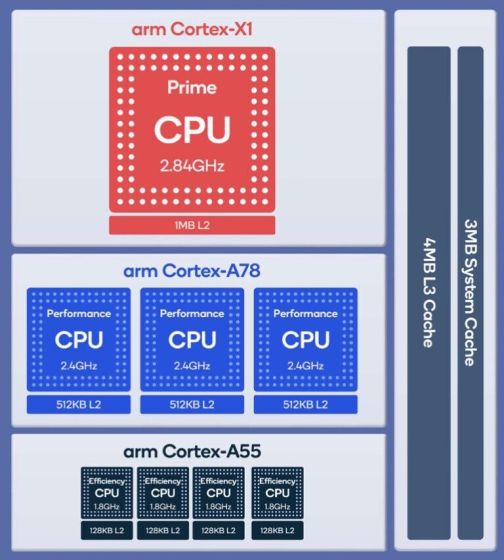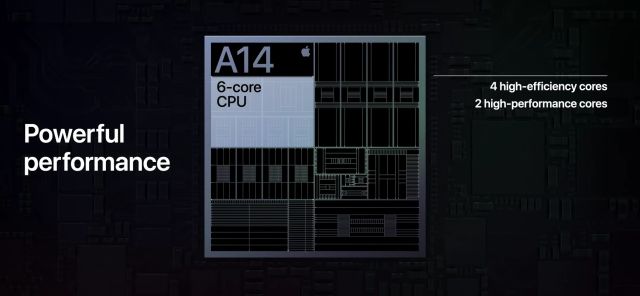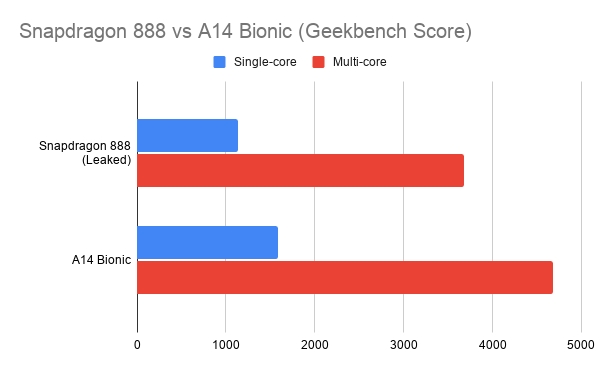Snapdragon 888 vs A14 Bionic: An In-depth Comparison
Here, we have mentioned all the topics we have covered in this comparison between Snapdragon 888 vs A14 Bionic. You can click on the link below to easily move to the relevant section. In case, you are interested in our last year’s comparison between Snapdragon 865 vs A13 Bionic then go through our linked article.
Compare Snapdragon 888 vs A14 Bionic
Specs
CPU
Starting with Qualcomm Snapdragon 888, unlike the past several years, Qualcomm has done some significant changes in CPU architecture this year. It comes with an 8-core Kryo 680 CPU, developed on the 5nm process node, with the new ARM Cortex-X1 core under the hood. If you are unaware, ARM designed a new high-performing CPU core called Cortex-X1 to compete against Apple’s A-series chips. And Qualcomm is the first chipmaker to implement this design on their mobile SoC. The Cortex-X1 is named Prime core and it’s clocked at 2.84GHz. Apart from that, Snapdragon 888 comes with three A78 performant cores which are clocked at 2.4GHz, and four A55 power-efficient cores clocked at 1.8GHz. While the new Cortex-X1 and A78 cores are great new additions, it’s sad to see Qualcomm still using the three-year-old A55 core on its flagship SoC. A55 has not gone through any update in the last three years and its power efficiency numbers are outranked by Apple’s A-series chips in 2020.
Overall, Qualcomm says Snapdragon 888 has seen 25% faster CPU performance in year-over-year (YoY) growth and has not shared any numbers on the power draw of the new CPU, except that it’s “incredible”. It’s clear that the Kryo 680 CPU on Snapdragon 888 has not brought a groundbreaking change that many of us have been waiting for. Talking about the Apple A14 Bionic, unlike Snapdragon 888’s octa-core CPU, it features an ARM-based, Apple-designed Hexa-core CPU. Built on the 5nm fabrication process by TSMC, the A14 Bionic retains the same 2+4 big.LITTLE CPU architecture. However, it has replaced the last year’s Lightning and Thunder cores with 2 high-performing Firestorm Big cores and 4 power-efficient Icestorm Little cores.
The Firestorm cores can go up to 3GHz clock speed in single-threaded scenarios and Icestorm cores can reach up to 1.8GHz. When any of the two cores are active, it can sustain the CPU frequency at 2.89GHz which is nothing sort of amazing. To put things into perspective, the A14 Bionic is around 17% faster than the last year’s A13 chip, but it still maintains a healthy 25% faster performance than the latest Snapdragon 888 SoC.
The main reason behind this performance jump is because Apple is consistently improving its power-efficient cores rather than just focussing on performant ones. The Icestorm cores are now 4 times faster and 3 times more power-efficient than Qualcomm’s aging A55 core. It’s not just about the clock speed as we have seen Snapdragon 865+ already reaching 3.1GHz last year and this time too, Snapdragon 888+ might have that peak frequency. Basically, if Qualcomm has to close the generational gap against Apple A-series chips then it has to start working on the power-efficient cores. As for now, the A14 Bionic remains the reigning king in terms of CPU, at least by a generation.
GPU
Coming to the GPU, it seems Snapdragon 888 has hit the ball out of the park. The Snapdragon 888 features the new Adreno 660 GPU which is said to be 35% faster than last year’s Snapdragon 865 processor. At the same time, it’s 20% more power-efficient over the last year’s processor. As a result, you can now have sustained gaming performance at a high refresh rate. The Snapdragongon 865 had brought support for 144Hz display panels, but it was unable to sustain high refresh-rate gaming for a longer time, as we saw while playing Fortnite and PUBG at 90FPS on OnePlus phones.
However, with Adreno 660 and the improved Snapdragon Elite Gaming, you can play high refresh-rate games for a much longer time without the device getting abnormally hot. It also comes with features such as Variable Rate Shading, HDR Gaming, and Game Quick Touch for improving rendering performance and reducing touch latency while gaming. Talking about Apple’s custom-designed, four-core GPU, it has seen an improvement of 20% over the last year’s A13 Bionic, which sounds quite incremental. However, if you consider Geekbench scores then A14 (12571) surpasses the powerful A12Z (11665) and A13 Bionic (7308) with flying colors. As for the comparison with Snapdragon 888, the A14 Bionic GPU is still more than a generation ahead even though Qualcomm managed to bring 35% YoY growth.
To conclude, while the GPU on Snapdragon 888 has surely gone through a huge improvement, it still lags behind Apple’s in-house GPU. Apple seems to be moving at a breakneck speed in terms of silicon design whether it’s CPU or GPU. It will be interesting to see how and when Qualcomm closes this performance gap in the coming years.
ISP
As it’s evident from Qualcomm’s track record, ISP is one of the areas where it shines and shines bright. With Spectra 580 ISP in Snapdragon 888, it has taken a generational leap with 35% faster performance and triple ISP architecture. It can capture 2.7 gigapixels per second without breaking a sweat. Apart from that, the new Spectra 580 ISP can capture up to 200MP photos and three photos at the same time at 28MP each. Not to mention, it can capture 120 burst photos in just one second. It means that while moving you will be able to take a much better shot on your Android device. Next, the Spectra 580 ISP can record 4K HDR videos from all three cameras simultaneously which is bonkers. The best part is that it can perform three computational HDR operations in a second and create HDR shots for the device to create an image stack. All of this is possible because of parallel processing through triple ISPs. Due to triple concurrency, you will be also able to switch between wide-angle and telephoto lens smoothly.
Lastly, Qualcomm has introduced a new low light architecture that lets you capture bright photos in a near-dark environment (0.1 lux). Basically, night mode is going to get even better on Android smartphones, thanks to the Spectra 580 ISP on Snapdragon 888. As for Apple’s ISP on the A14 Bionic, the company has not detailed much about its architecture. However, it has said the new ISP can capture “unprecedented detail, texture, and minimal noise”. While iPhone is the undisputed king at video capturing, it’s great to see Qualcomm doing some great work to improve both image and video capturing on Android devices. We will have to wait and see how Android OEMs implement Qualcomm’s hardware offering to improve image quality.
AI and ML
AI and ML is another domain where Qualcomm has a huge lead over Apple. The Snapdragon 888 features the 6th-gen AI accelerator with Hexagon 780 DSP under the hood. It can process 26 TOPS (trillion operations per second) which is astounding, to say the least.
For your perspective, the 16-core neural engine on the A14 Bionic can only perform 11 TOPS and last year’s Snapdragon 865 was capable of performing 16 TOPS. Basically, Snapdragon 888 is at least two generations ahead of Apple’s A-series chips when it comes to AI and ML operations.
Modem and Wireless Technologies
Coming to Modem and other wireless technologies, Qualcomm is already the leader in this segment. In fact, with iPhone 12, Apple has turned to Qualcomm for wireless connectivity. The Snapdragon 888 features the new X60 modem which is 5G-ready and integrated right into the SoC itself. Unlike last year where the modem was discrete, this year Qualcomm has managed to house it with the rest of the SoC which should bring down cost and improve battery efficiency as well. As for the numbers, it supports download up to 7.5Gbps and upload up to 3Gbps.
The unique part about the X60 modem is that it now supports 5G carrier aggregation across FDD and TDD spectrums which was not available on last year’s X55 modem. Apart from that, you have got support for mmWave and sub-6GHz with MIMO; compatibility with NSA, SA, TDD, and FDD modes. Lastly, it brings support for the latest WiFi 6E (6GHz WiFi), Bluetooth 5.2, and NavIC support. Qualcomm’s X55 modem was found in iPhone 12 teardown / Source: iFixit Talking about the A14’s modem, it’s using Snapdragon’s last-gen X55 modem which brings 5G capability to the iPhone 12 series. As you guessed correctly, it’s a discrete modem integrated separately to the logic board. The download and upload speed is similar to the X60 modem and supports features such as MIMO, carrier aggregation, and more. Furthermore, there is support for WiFi 6 and Bluetooth 5.0. In tandem, with Qualcomm’s modem on iPhone 12 series, you are going to get a much better wireless experience.
Snapdragon 888 vs A14 Bionic: Who Wins This Year?
As we went through the article, it’s more of the same as how the silicon war played out last year. There is an incremental update in CPU performance despite using the powerhouse Cortex-X1 on the Snapdragon 888. And even with a meaty 35% jump in Snapdragon 888’s GPU performance, it’s still behind Apple’s custom GPU. As for the ISP, AI, and Modem, Snapdragon clearly has an upper hand over the A-series chips. As mentioned earlier, Qualcomm needs to up its game on CPU design and update the power-efficient cores to compete with Apple Silicon. The way things are right now, it does not seem things are going to change drastically in the next few years. So to conclude, the Apple A14 Bionic still holds the top spot when it comes to the most powerful smartphone chipset. But it will be exciting if Qualcomm manages to pull off a miracle.







